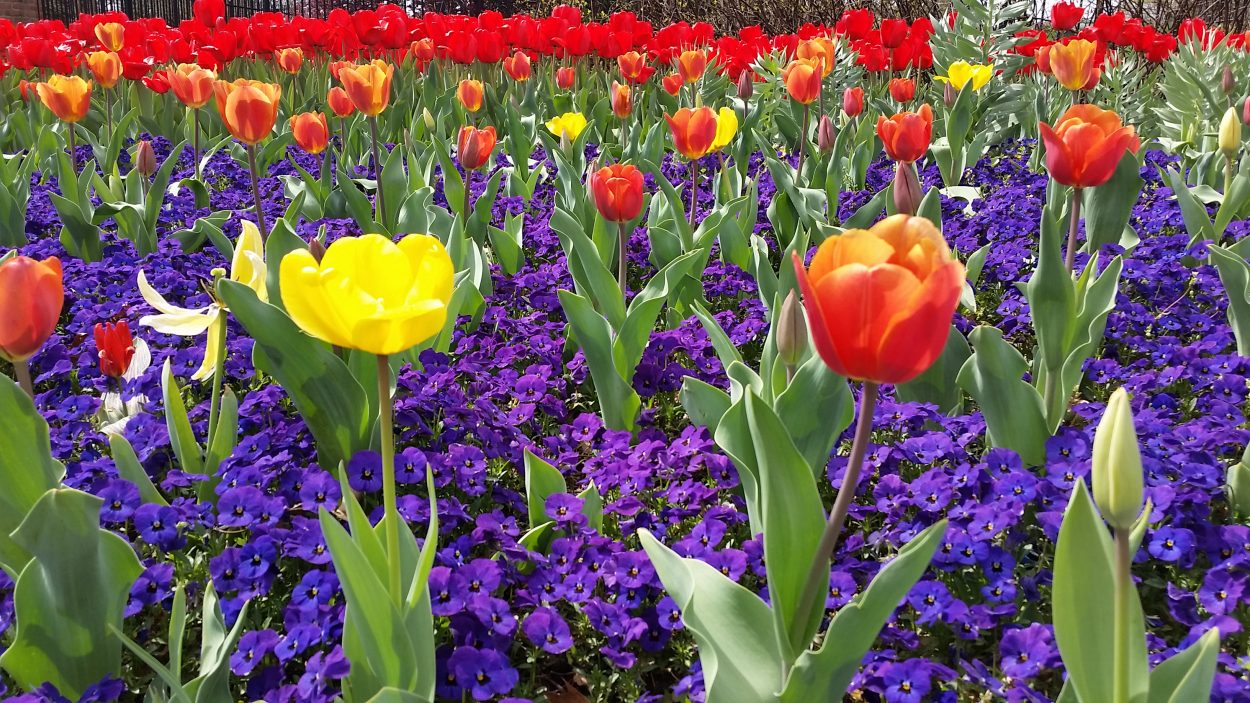Cutting Gardens: Inspiration
Vases and jars brimming with fresh-cut flowers make a house “home.” It can create a dilemma, though – where to find flowers? Florists can be pricey, and commercial growers leave a carbon footprint. You can raid your own yard, but that leaves gaps in the landscape. Plus there’s guilt from robbing outdoor pretties for the sake of indoor pleasure.

McMinn’s cutting garden provides a rich source for arrangements since bulbs, annuals and flowering shrubs are planted together. Photo by Laurie McMinn
Laurie McMinn, a Virginia Nursery and Landscape Association VNLA-certified horticulturist at Lewis Ginter Botanical Garden, has another solution: create a designated cutting garden.
“Some think a cutting garden is lots of rows of annuals, out of the way and not a pretty sight,” McMinn noted. “I say, ‘Think beyond flowers.’”
McMinn’s own cutting garden is an inviting extension of her home landscape. She plants annuals and perennials for splashes of color and fragrance, complementing them with evergreens, flowering trees and shrubs. Together, the flowers, foliage and berries provide four-season interest, as well as a continuous supply for her floral arrangements and gifts.
Planting time is soon, so planning time is now. McMinn shared these additional tips to make your cutting garden attractive, colorful and fragrant, as well as useful.
Location: Choose a flat site with six hours of direct sun, or at least morning sun. Otherwise, plan a cutting garden for shade-tolerant plants.
Plant selection: Consider form and function, as well as disease resistance and rebloom capability. Tall, spiky flowers, such as snapdragon, provide an eye-catching backdrop for arrangements. Rounded blossoms, such as daisies, provide focal points. Plant fillers can range from soft baby’s breath and ferns to evergreen twigs, variegated foliage, leafless branches, berries and seedpods.
Quantity: Plant several of the same variety to last the season. Also plant multiples of one-time bloomers.

Multiple plantings and layering maximize space and extend availability of flowers for cutting. Photo by Lynn Kirk
Design: Plant in blocks or rows, since ease of access is more important than bed design. For critter-loved plants, such as tulips, consider using hanging baskets. Create pathways or add stepping stones to avoid compacting the soil while maintaining and gathering. Add stakes or trellises while planting, so as not to disturb plants during their growth.
Gathering: As the garden matures, extend arrangements’ longevity by cutting flower buds or blossoms just as they open. If wind or rain storm is predicted, save flowers with large blooms and many petals, such as peonies, by gathering them in advance. Look within plant foliage and turn leaves over to discover different colors not exposed to the sun. Use your imagination as you gather by experimenting with different color combinations, mixing various textures and using the unexpected.
Increasing longevity: To lessen drainage from stems, carry cut daffodils upside down until arranged. Dip milky-stemmed plants—including poppy, milkweed and dahlia—into boiling water for 10 seconds as soon as cut. Or when possible, cut flower stems under water so that the unbroken water column is maintained in the stems’ conducting tissues. To help preserve open seedpods, such as milkweed, apply hairspray.
Containers: Keep a lookout for unusual, no-cost vases, whether repurposed household containers or yard-sale finds. Scout through forgotten sheds, attics and basements with fresh eyes.
Arrangements: Water needs vary, so tuck vials in arrangements for water-thirsty plants. With compact plants like marigold and begonia, use the whole plant and add strong-stalk flowers for interest.
Journal: Keep notes for reference from year to year. “You’ll know what’s happy in your own garden only by trial and error,” McMinn said.
“A cutting garden will save a lot of money, and you can share your garden through flower and seed exchange,” McMinn said. “Your creative, yet inexpensive arrangements will also impress your friends.”
Starters for cutting gardens:
Spring = Columbine, daffodil, iris, peony, tulips, pansies
Early to mid-summer = Coreopsis, bee balm, lavender, coneflower, daisy
Late summer to autumn = Mum, garden phlox, sunflower, anemone
Winter = Hellebore, mahonia, bulbs for forcing indoor blooms
Article originally published in the Richmond Times-Dispatch on March 2017.